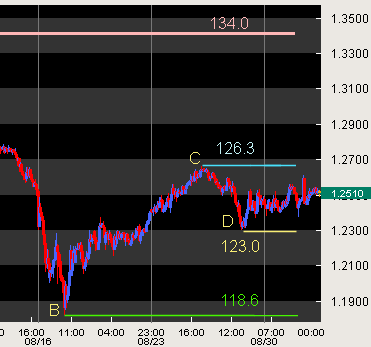Fibonacci is alive and well - in AUD:SGD
By Murray Bourne, 03 Sep 2007
Observations show that the amount of a market move tends to follow a pattern of:
- Move a lot
- Retrace a bit
- Move another lot - or retrace again
The amount of each move tends to follow Fibonacci retracement levels:
- 0.382
- 0.500
- 0.618
The market volatility over the last few weeks (due to the sub-prime mortgage debacle in the US) has surprised a lot of market watchers. The volatility has been felt by all types of markets, including forex (foreign exchange).
Let's look at an example which how Fibonacci retracement levels can be observed in the recent turmoil.
SGD-AUD and Fibonacci
Here is a chart of the Australian dollar against the Singapore dollar for the last 30 days (end July to early September 2007. Click to enlarge.)
Let's zoom in on the latter part of the chart to see what is happening.

The peak of 134.0 (point A - the pink line) was reached on 26th July and the trough (point B) was around 118.6 on 17th August. That's a huge 15.4c drop.
Now, 0.5 × 15.4 = 7.7c
Observe that the AUD:SGD rate retraced to 126.3 (point C) on the 27th August was right on the 0.500 Fibonacci retracement level
118.6 + 0.5 × 15.4 = 118.6 + 7.7 = 126.3
Finally, Point D (29th August) is at 123.0.
Half of the previous rise is 0.5 × 7.7 = 3.85.
126.3 − 3.85 = 122.45. Pretty close to the actual figure of 123.0.
As mentioned above, other possible multiples are 0.382 and 0.618 times the previous move. Traders use these figures to make buy and sell orders in the hope of making money (see Fibonacci method in Forex charts and Money Charts and Fibonacci.).
The good traders would have done very well over the last month. They love extreme volatility.
Be the first to comment below.
